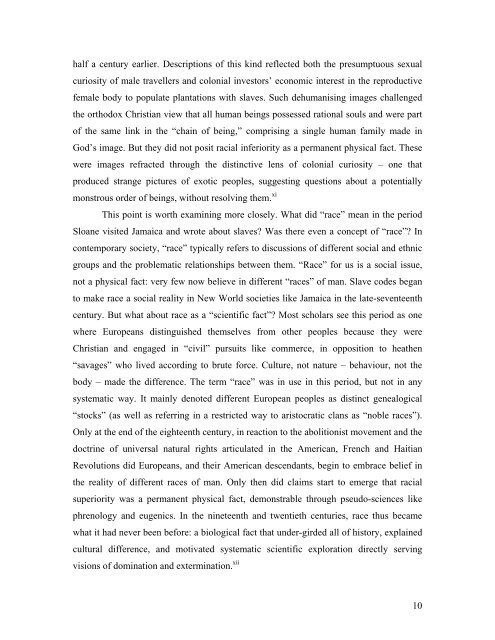Slavery in the Cabinet of Curiosities: Hans ... - British Museum
Slavery in the Cabinet of Curiosities: Hans ... - British Museum
Slavery in the Cabinet of Curiosities: Hans ... - British Museum
You also want an ePaper? Increase the reach of your titles
YUMPU automatically turns print PDFs into web optimized ePapers that Google loves.
half a century earlier. Descriptions <strong>of</strong> this k<strong>in</strong>d reflected both <strong>the</strong> presumptuous sexual<br />
curiosity <strong>of</strong> male travellers and colonial <strong>in</strong>vestors’ economic <strong>in</strong>terest <strong>in</strong> <strong>the</strong> reproductive<br />
female body to populate plantations with slaves. Such dehumanis<strong>in</strong>g images challenged<br />
<strong>the</strong> orthodox Christian view that all human be<strong>in</strong>gs possessed rational souls and were part<br />
<strong>of</strong> <strong>the</strong> same l<strong>in</strong>k <strong>in</strong> <strong>the</strong> “cha<strong>in</strong> <strong>of</strong> be<strong>in</strong>g,” compris<strong>in</strong>g a s<strong>in</strong>gle human family made <strong>in</strong><br />
God’s image. But <strong>the</strong>y did not posit racial <strong>in</strong>feriority as a permanent physical fact. These<br />
were images refracted through <strong>the</strong> dist<strong>in</strong>ctive lens <strong>of</strong> colonial curiosity – one that<br />
produced strange pictures <strong>of</strong> exotic peoples, suggest<strong>in</strong>g questions about a potentially<br />
monstrous order <strong>of</strong> be<strong>in</strong>gs, without resolv<strong>in</strong>g <strong>the</strong>m. xi<br />
This po<strong>in</strong>t is worth exam<strong>in</strong><strong>in</strong>g more closely. What did “race” mean <strong>in</strong> <strong>the</strong> period<br />
Sloane visited Jamaica and wrote about slaves? Was <strong>the</strong>re even a concept <strong>of</strong> “race”? In<br />
contemporary society, “race” typically refers to discussions <strong>of</strong> different social and ethnic<br />
groups and <strong>the</strong> problematic relationships between <strong>the</strong>m. “Race” for us is a social issue,<br />
not a physical fact: very few now believe <strong>in</strong> different “races” <strong>of</strong> man. Slave codes began<br />
to make race a social reality <strong>in</strong> New World societies like Jamaica <strong>in</strong> <strong>the</strong> late-seventeenth<br />
century. But what about race as a “scientific fact”? Most scholars see this period as one<br />
where Europeans dist<strong>in</strong>guished <strong>the</strong>mselves from o<strong>the</strong>r peoples because <strong>the</strong>y were<br />
Christian and engaged <strong>in</strong> “civil” pursuits like commerce, <strong>in</strong> opposition to hea<strong>the</strong>n<br />
“savages” who lived accord<strong>in</strong>g to brute force. Culture, not nature – behaviour, not <strong>the</strong><br />
body – made <strong>the</strong> difference. The term “race” was <strong>in</strong> use <strong>in</strong> this period, but not <strong>in</strong> any<br />
systematic way. It ma<strong>in</strong>ly denoted different European peoples as dist<strong>in</strong>ct genealogical<br />
“stocks” (as well as referr<strong>in</strong>g <strong>in</strong> a restricted way to aristocratic clans as “noble races”).<br />
Only at <strong>the</strong> end <strong>of</strong> <strong>the</strong> eighteenth century, <strong>in</strong> reaction to <strong>the</strong> abolitionist movement and <strong>the</strong><br />
doctr<strong>in</strong>e <strong>of</strong> universal natural rights articulated <strong>in</strong> <strong>the</strong> American, French and Haitian<br />
Revolutions did Europeans, and <strong>the</strong>ir American descendants, beg<strong>in</strong> to embrace belief <strong>in</strong><br />
<strong>the</strong> reality <strong>of</strong> different races <strong>of</strong> man. Only <strong>the</strong>n did claims start to emerge that racial<br />
superiority was a permanent physical fact, demonstrable through pseudo-sciences like<br />
phrenology and eugenics. In <strong>the</strong> n<strong>in</strong>eteenth and twentieth centuries, race thus became<br />
what it had never been before: a biological fact that under-girded all <strong>of</strong> history, expla<strong>in</strong>ed<br />
cultural difference, and motivated systematic scientific exploration directly serv<strong>in</strong>g<br />
visions <strong>of</strong> dom<strong>in</strong>ation and exterm<strong>in</strong>ation. xii<br />
10

















